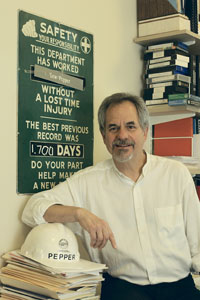 |
|
||
|
|||
Haste makes waste matter
SPH researcher aids nuclear arms workers exposed to beryllium dust
By Cynthia K. Buccini
|
|
|
|
Lew Pepper has developed a medical screening program for former nuclear weapons workers at the U.S. Department of Energy’s Nevada Test Site. Photo by Vernon Doucette |
|
During World War II and throughout the Cold War, tens of thousands of workers across the United States were exposed to beryllium, a lightweight, durable metal found in a wide variety of materials used to produce nuclear weapons.
Looking back, it’s unclear what safeguards were in place to protect workers from the toxic substance. When inhaled, beryllium dust can cause lung diseases for which there are no cure. “Beryllium was integral to the entire nuclear weapons complex,” says Lew Pepper, an SPH assistant professor of environmental health. “There was a rush to develop the atomic bomb. The United States was convinced Germany was building one, and they went at breakneck speed to create this bomb, tossing safety to the wind, I assume. The same attitude toward safety — that it wasn’t the primary concern of the weapons industry — was recounted by people who worked on weapons testing from the 1950s through the 1980s.”
Pepper leads a team of SPH scientists identifying workers who were exposed to beryllium at three facilities, one in Nevada and two in Massachusetts, to find out if their health has been affected by the substance so that they can get medical help and compensation.
As of last summer, Pepper’s research team had screened nearly 3,500 former workers at the Department of Energy’s Nevada Test Site, 60 miles north of Las Vegas. About 800 nuclear weapons tests were conducted at the site from 1951 to 1992, and approximately 50,000 people worked there or passed through during that period. According to Pepper, who has been directing a medical screening program at the site for several years with a Department of Energy (DOE) grant, approximately 2,000 of the workers his group has screened were exposed to beryllium.
Of those 2,000, approximately 2 percent have been found to suffer from beryllium sensitivity, a medical condition commonly attributed to inhaling beryllium dust. People diagnosed with beryllium sensitivity are clinically healthy, but have an immune response to the substance, Pepper says, similar to an allergic reaction. In addition, they are at risk for developing chronic beryllium disease, a lung ailment whose symptoms — coughing, shortness of breath, chest and joint pain, fever, weight loss — can develop decades after exposure. Chronic beryllium disease has no cure, but is treatable with anti-inflammatory medications.
There have been numerous cases of chronic beryllium disease diagnosed among the Nevada site’s former workers with beryllium sensitivity. “They have been provided compensation and lifetime medical benefits,” Pepper says, “and they continue to be evaluated periodically.”
Last year, SPH was awarded a DOE contract to establish a similar program to find and screen former workers exposed to beryllium at two Massachusetts facilities: Wyman-Gordon Company, in North Grafton, and Norton Abrasives, in Worcester, both of which produced beryllium components for the federal government in the ’40s, ’50s, and ’60s.
So far, of 200 former Wyman-Gordon workers screened, 5 percent are beryllium-sensitive. Another 160 await screening. The retired workers with beryllium sensitivity haven’t undergone clinical evaluations, so Pepper doesn’t know yet if they have chronic beryllium disease. At Norton, he says, “We’re trying to assemble a picture of beryllium use. We’re starting to do outreach among those workers.”
In addition to testing for beryllium exposure, Pepper’s medical screening program identifies workers who were exposed to radiation, silica dust, asbestos, diesel exhaust, and excessive noise. The workers complete detailed medical and work-history questionnaires and then undergo screenings, which include physicals, chest X-rays, and blood, breathing, and hearing tests. If their health has been affected, they get help with medical referrals, future screenings, treatment, and compensation from the DOE.
Pepper notes that his screening model for beryllium has broad implications because beryllium exposure doesn’t affect just people who work directly with the material. In 2002, testing of more than 200 workers in a DOE office building in Las Vegas — where beryllium had been machined before the facility was rehabbed — found that more than 5 percent had beryllium sensitivity.
“When you have a beryllium facility and you attempt to clean it up and make it a general-use facility, how clean is clean?” Pepper asks. “Is residual beryllium contamination responsible for these cases of sensitization, of which, we think, 80 percent will go on to develop chronic beryllium disease? That has tremendous implications for the Department of Energy, because as they segue from bomb-maker to friend of the environment, and they try to rehab these buildings to multiuse facilities, how do they assure the people who work there that the facilities are clean and safe? That’s a big problem.”
![]()
3
December 2004
Boston University
Office of University Relations
